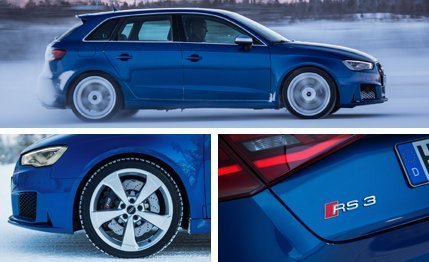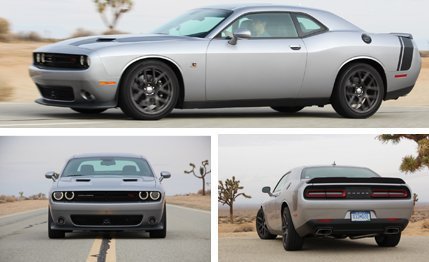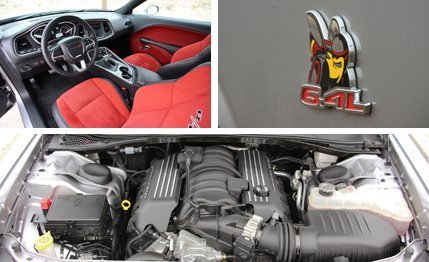
 Instrumented Test
Instrumented Test
The performance-car world has turned a corner. It’s a corner that, for a long time, those of us who savor engaging one’s left leg and right arm to shift gears have been reluctant to admit even exists: In most instances, no objective case can be made for choosing a manual over an automatic when it comes to performance. Automatic gearboxes have improved so much that oftentimes they are both more fuel-efficient and quicker than their manual counterparts. Curse you, technology!
The latest example of this reality is the 2015 Dodge Challenger R/T Scat Pack, one of the more beastly muscle cars to ever have leapt from a Detroit-based engineering department. Sharing its naturally aspirated, 392-cubic-inch pushrod V-8 (Dodge likes to cite the displacement in cubic inches because heritage!) with the pricier, somewhat higher-tech SRT 392 model, the R/T Scat Pack comes with a choice of a six-speed Tremec TR6060 manual or, for $1400 more, an eight-speed paddle-shifted TorqueFlite automatic. We tested the manual version a few months ago, and that car also lost a three-way comparison test with a Ford Mustang GT and a Chevrolet Camaro SS 1LE, yet this Challenger impressed us with its brute force, bad-ass attitude, and ear-shredding exhaust note. The automatic version, it turns out, is actually quite satisfying to drive, too.
First, the numbers. We blasted to 60 mph in a blistering 4.2 seconds, hit triple-digit speeds in 9.6 seconds, and passed the quarter-mile mark in 12.6 seconds at 114 mph. The manual Scat Pack hit those same benchmarks in 4.4 seconds, 10.2 seconds, and 12.9 seconds at 113 mph. The improvement is in no part attributable to the Scat Pack’s programmable launch control, which is part of the standard Performance Pages app. Our test driver, senior editor Tony Quiroga, noted that, regardless of how low he set launch rpm using the system, some tenths were lost to excess wheelspin. The best way to launch, we found, is simply to ease into the throttle through first gear, dipping deeper as second engages and resisting the urge to mash the pedal until you’re midway through second gear. Otherwise, it’s a cloudy day in the neighborhood.


The transmission itself is a honey, as we’ve noted in our reviews of other vehicles that use it. Demure as a housecat in its default settings and bordering on violent in its more aggressive settings, the ZF-designed TorqueFlite eight-speed unit delivers satisfyingly quick and rev-matched downshifts at the tug of the left paddle. It’s not quite as speedy to swap ratios as a dual-clutch automatic, but it’s far from your typical slushbox. We give serious kudos to Dodge’s engineers for tuning this transmission to match the raucous personality of the Hemi underhood.
For what it’s worth, we expect that the launch control would come in handy on an actual drag strip, especially with slicks, but we test in conditions more like those you’d find in the real world. Still, 4.2 seconds to 60 is pretty damn good for a 4261-pound full-size two-door sedan—which is essentially what the Challenger is. Just as impressive are the Brembo brakes (with four-piston calipers at each corner), which yank the big guy down to a stop from 70 mph in just 154 feet.
The Scat Pack’s throttle is also quite touchy even with the powertrain in its most docile setting, regularly provoking the same wheelspin we experienced at the test track. This is less of a problem for us, but it becomes worrisome when we think about valets screeching backward into parking spots. And when the roads get slippery, well, suffice it to say that the Scat Pack is a fair-weather friend.
The Challenger Scat Pack can turn surprisingly well, too, thanks to quick steering (just 2.3 turns lock-to-lock) that can be dialed up both in terms of effort and feel via the Performance Pages. But be sure you know how to catch a slide before you turn off the stability control, as the 245/45 Goodyear Eagle F1 Supercar tires generated 0.90 g of lateral grip on our skidpad; that’s a decent number, but it’s not so sticky that the rear won’t break loose fairly easily under power. Even when that happens, though, the body remains heroically flat thanks to a stiffened suspension. We noted moderate understeer on the level skidpad, but if you’re heading downhill on, say, a mountain road, it’s best to respect the fact that 55 percent of the car’s mass is riding over the front wheels—and that this Dodge is all too happy to push your line wide.


While the automatic Scat Pack starts at $39,890, this particular example was loaded with options, including radar cruise control and other driving aids, navigation, a sunroof, upgraded speakers, and the $1995 Appearance group (including blackout trim, black 20-inch wheels, and bumblebee stripes). It also had a red-and-black faux-suede and leather interior that contrasted dramatically with its stormy gray paint.
The sticker thus had an eye-watering bottom-line price of $47,360, a few hundred bucks more than the $46,990 SRT 392. For that kind of coin, we might recommend stepping up to a basic SRT 392, if only to get the adjustable Bilstein shocks—they keep the car buttoned down in corners but also impart a far more highway-friendly ride. The 392 also has stronger brakes and comes with a complimentary day of driver training.
While the Challenger R/T Scat Pack is heavy no matter what transmission you choose, and the automatic is unlikely to change the car’s standing in the aforementioned comparison test, it is a very fast and charismatic muscle car that delivers on every promise made by its bodacious styling. We dig it.